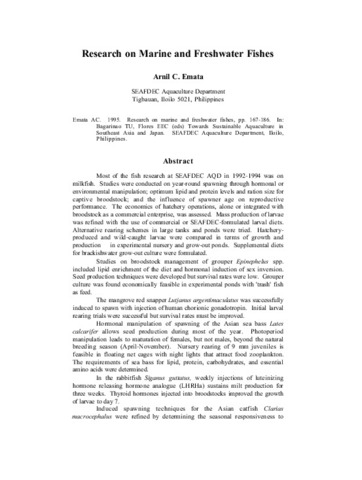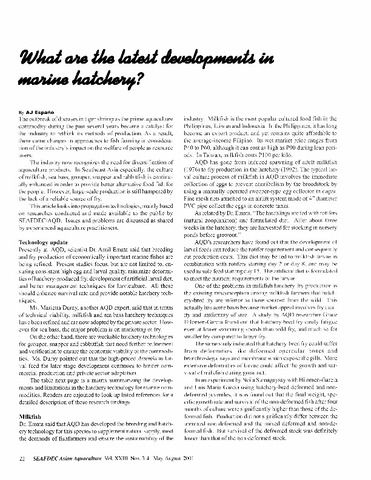Effect of stocking density and feed on the growth and survival of sea bass fry Lates Calcarifer (Bloch)
- Global styles
- MLA
- Vancouver
- Elsevier - Harvard
- APA
- Help

View/
Date
1993Page views
2,577ASFA keyword
AGROVOC keyword
Taxonomic term
Metadata
Show full item record
Share
Abstract
The effect of two levels of stocking density (5 and 7 m-2) and the two types of feed [trash fish only (TF), and a mixed feed (MF) (mixture of 25% trash fish and 75% commercial pelleted feed)] on the growth, apparent food conversion ratio (FCR) and survival of the thirty-day old sea bass fry were investigated. The fry were stocked in 144 m2 earthen ponds and reared for 45 days. The result showed that, in general, the lower density increased but the MF decreased the survival, specific growth rate (SGR) and FCR of sea bass fry. Statistically, there was no significant effect of treatments on survival, whereas SGR and FCR affected differently. With TF, both were higher at 5 m-2 and lower at 7 m-2. With MF, SGR was higher at 5 m-2 than at 7 m-2 and the FCR was most efficient at 5 m-2 than at 7 m-2. There was no interaction between the type of feed and the stocking density. For the efficient utilization of feed, the TF+5 m-2 treatment was the best for rearing seabass to fingerlings.
Suggested Citation
Triño, A. T., & Bolivar, M. E. C. (1993). Effect of stocking density and feed on the growth and survival of sea bass fry Lates Calcarifer (Bloch). International Journal of Tropical Agriculture , 11(3), 163-167. http://hdl.handle.net/10862/1437
Type
ArticleISSN
0254-8755Collections
- Journal Articles [1258]
Related items
Showing items related by title, author, creator and subject.
-
Research on marine and freshwater fishes
Emata, Arnil C. (Aquaculture Department, Southeast Asian Fisheries Development Center, 1995)Most of the fish research at SEAFDEC AQD in 1992-1994 was on milkfish. Studies were conducted on year-round spawning through hormonal or environmental manipulation; optimum lipid and protein levels and ration size for ... -
What are the latest developments in marine hatchery?
Españo, A. J. (Aquaculture Department, Southeast Asian Fisheries Development Center, 2001) -
Netcage rearing of the Asian seabass Lates calcarifer (Bloch) in brackishwater pond: The technical and economic efficiency of using high protein diets in fingerling production
Madrones-Ladja, Jocelyn A.; Catacutan, Mae R. (College of Agriculture, University of the Philippines Los Baños, 2012)Intensification in the grow-out culture of high-value fish requires a large quantity of quality fingerlings. Fingerling production is a component of fish farming that comprises nursery and grow-out culture, and may be a ...





